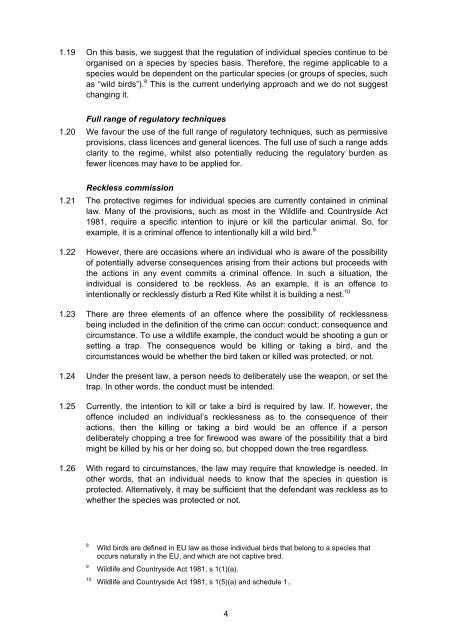Wildlife consultation paper summary - Law Commission
Wildlife consultation paper summary - Law Commission
Wildlife consultation paper summary - Law Commission
You also want an ePaper? Increase the reach of your titles
YUMPU automatically turns print PDFs into web optimized ePapers that Google loves.
1.19 On this basis, we suggest that the regulation of individual species continue to be<br />
organised on a species by species basis. Therefore, the regime applicable to a<br />
species would be dependent on the particular species (or groups of species, such<br />
as “wild birds”). 8 This is the current underlying approach and we do not suggest<br />
changing it.<br />
Full range of regulatory techniques<br />
1.20 We favour the use of the full range of regulatory techniques, such as permissive<br />
provisions, class licences and general licences. The full use of such a range adds<br />
clarity to the regime, whilst also potentially reducing the regulatory burden as<br />
fewer licences may have to be applied for.<br />
Reckless commission<br />
1.21 The protective regimes for individual species are currently contained in criminal<br />
law. Many of the provisions, such as most in the <strong>Wildlife</strong> and Countryside Act<br />
1981, require a specific intention to injure or kill the particular animal. So, for<br />
example, it is a criminal offence to intentionally kill a wild bird. 9<br />
1.22 However, there are occasions where an individual who is aware of the possibility<br />
of potentially adverse consequences arising from their actions but proceeds with<br />
the actions in any event commits a criminal offence. In such a situation, the<br />
individual is considered to be reckless. As an example, it is an offence to<br />
intentionally or recklessly disturb a Red Kite whilst it is building a nest. 10<br />
1.23 There are three elements of an offence where the possibility of recklessness<br />
being included in the definition of the crime can occur: conduct; consequence and<br />
circumstance. To use a wildlife example, the conduct would be shooting a gun or<br />
setting a trap. The consequence would be killing or taking a bird, and the<br />
circumstances would be whether the bird taken or killed was protected, or not.<br />
1.24 Under the present law, a person needs to deliberately use the weapon, or set the<br />
trap. In other words, the conduct must be intended.<br />
1.25 Currently, the intention to kill or take a bird is required by law. If, however, the<br />
offence included an individual’s recklessness as to the consequence of their<br />
actions, then the killing or taking a bird would be an offence if a person<br />
deliberately chopping a tree for firewood was aware of the possibility that a bird<br />
might be killed by his or her doing so, but chopped down the tree regardless.<br />
1.26 With regard to circumstances, the law may require that knowledge is needed. In<br />
other words, that an individual needs to know that the species in question is<br />
protected. Alternatively, it may be sufficient that the defendant was reckless as to<br />
whether the species was protected or not.<br />
8 Wild birds are defined in EU law as those individual birds that belong to a species that<br />
occurs naturally in the EU, and which are not captive bred.<br />
9 <strong>Wildlife</strong> and Countryside Act 1981, s 1(1)(a).<br />
10 <strong>Wildlife</strong> and Countryside Act 1981, s 1(5)(a) and schedule 1..<br />
4

















